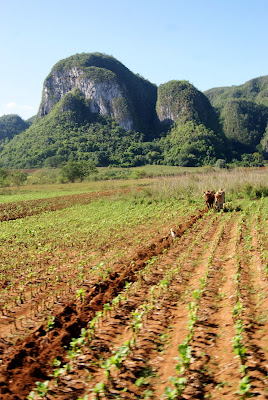
Viñales is only hours from Havana, but a world apart. Its lush
rolling green hills are dotted with fincas, lines with dirt roads, and sprinkled
with massive limestone mogotes. The rich soil and unique microclimate
make Viñales home to the world’s best tobacco.
As part of Cuba’s tourist trail, Viñales overflows with
casas particulares, a guesthouse-homestay hybrid, restaurants, and tours to the
surrounding farms and caves. This provided us with the ideal opportunity to go
for a horseback riding tour, my first and last.
For years Win has been trying to get me to go horseback
riding, and there have been no shortage of chances to do so. I have always been
vehemently opposed, as I find horse to be unpredictable in a way that terrifies
me. Now, I know there are plenty of people who absolutely love horses and
horseback riding. We all have our things.
But, confronted with the beauty of Viñales and the chance to
face a fear and try something new, I agreed (albeit begrudgingly).
As a novice horseback rider, wracked with fear, our
Spanish-speaking guide gave us the following instructions once atop the horse:
left, right, stop, walk. My small, young horse, not being a car, did not
respond to commands as such and promptly freaked out. She panicked, I panicked,
she tried to buck me off, lost balance, and fell over, taking me down for the
ride.
That’s when I found out that the quickest way to win an argument
is to have a horse fall on you. I also learned that Cubans are not wont to take
that crybaby bullshit, so I ended up riding a horse (a calmer horse) for the
next four hours.
It was four hours of blind fear, riding through gorgeous landscapes,
limping around farms and caves, and thinking of ways to combine my scant
Spanish skills to ask our guide nicely to slow the hell down. We gained some insight into the tobacco growing process, as well as how communism and farm life interact (hint: 90 percent of the crop goes to the government).
We also met whatever this creature is.
In the end, I spent the rest of our vacation in various
states of limping and healing (partially due to the fact that horses are heavy
and partially to the fact of having ridden a horse for that long in general).
But now I know that I can get back on the horse, in the most literal way
imaginable.





























